Nokia 808 PureView Review
Excitement, about a Symbian phone? The Nokia 808 PureView has forced many to reconsider their platform loyalties by virtue of its big number boast: 41-megapixels of camera goodness. The surprise stand-out of Mobile World Congress, the 808 PureView is the first public evidence of a five year labor of love inspired by ultra-high-resolution satellite photography. There's compromise galore involved, however, to join the early PureView train, so is it worth it? Read on for the full SlashGear review.
Hardware
Miniaturization can only get you so far: if you want 41-megapixels – and Nokia really does – then you have to accept some heft with it. As a result the 808 PureView is a chunky phone, measuring in at 123.9 x 60.2 x 13.9 mm and 169 grams, though it's biased toward the lens section with its oversized sensor. In the hand, though, it's actually quite a pleasant thing to hold: the textured plastic back cover feels high-quality and sturdy, and your forefinger butts naturally against the curve of the camera hump.
That's not to say you don't notice it when it's in your pocket. In contrast to the slimline devices we've grown used to, the 808 PureView makes for a considerable bulge; we could fit it into a jeans pocket, front or back, but it wasn't the most comfortable we've ever been.
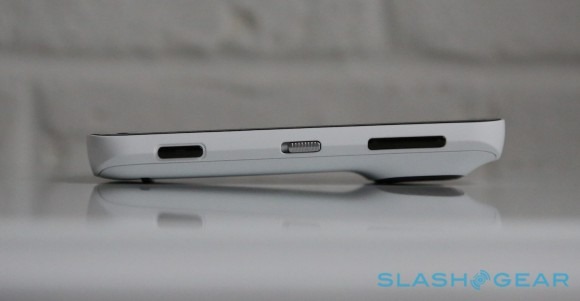
Controls include a three-button strip along the front, for call, menu and end/power, along with a volume rocker, lock switch and dedicated two-stage camera key on the right edge. Along the top there's a micro HDMI port (for use with Nokia's CA0198 HDMI kit) under a flap, a microUSB port for charging, and a 3.5mm headphone socket. Nokia includes a wired hands-free kit of decent audio quality, though we had no issues using third-party headsets with the phone.
Up front there's a 4-inch AMOLED ClearBlack display clad in a sheet of Corning Gorilla Glass. As with all OLED-based phones it has great viewing angles, contrast and color saturation; however, it's also running at a mere 360 x 640 resolution, and that means individual pixels are inescapable. The grittiness is visible from the outset, as soon as the start-up Nokia logo appears, and permeates throughout the phone experience. Considering the imaging focus of this phone, it's a disappointment.
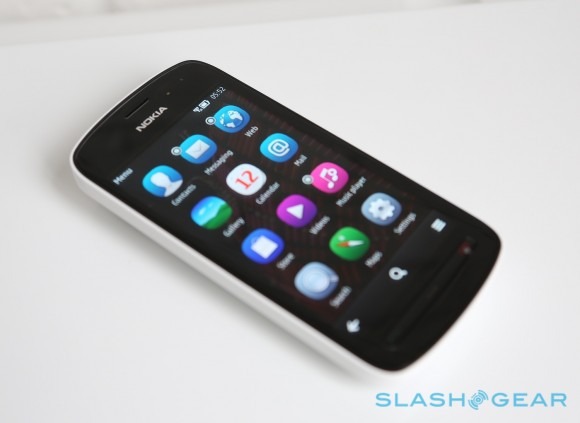
Inside, the 808 PureView packs one of the fastest processors to grace a Symbian device, a single-core ARM 11 running at 1.3GHz. It's paired with 512MB of RAM and 16GB of storage, expandable with up to 32GB microSD cards. Connectivity includes pentaband HSPA (up to 14.4Mbps down/5.76Mbps up, networking depending) which means support for both AT&T and T-Mobile 3G in the USA, along with Bluetooth 3.0, WiFi b/g/n, NFC and quadband GSM/EDGE. Slot in the optional microUSB to USB Host adapter and you can attach peripherals like USB drives, and there's A-GPS/GPS for navigation and photo geotagging.
Software and Performance
Software is the 808 PureView's Achilles' heel. Symbian, rebranded Nokia Belle in this latest iteration, is old in the tooth and considered outclassed by all but the staunchest of fans. With its UI borrowing some elements of Android – such as the drop-down notifications bar and the differently sized homescreen widgets – and sharing the squircle iconography of MeeGo on the N9 it's certainly the best looking iteration of Symbian to-date, but day-to-day usability is still a pain.
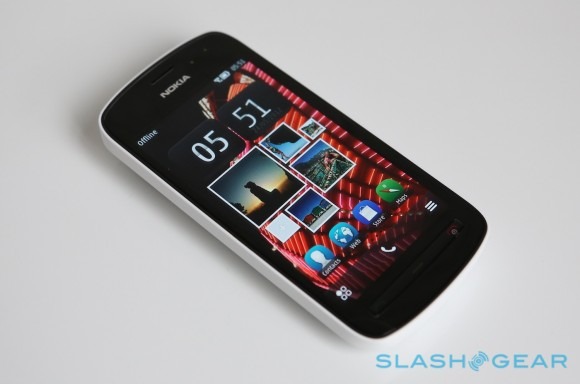
What's arguably the deal-breaker for Nokia Belle here is the performance. On the Nokia 700, which also runs Belle on a 1.3GHz single-core, we found ourselves conceding that it could make a reasonable entry-level device for the fledgling smartphone audience. Somewhere along the line, however, the 808 lost whatever turn of speed the 700 managed to squeeze from the processor.
The homescreen is fairly swift, but the 808 soon runs out of steam once you get into the apps. In the messaging app we'd sometimes have hammered out a half-word or so before the on-screen keyboard caught up; scroll fast through a full gallery and you'll see nothing but placeholder thumbnails, turning navigating images into guesswork.
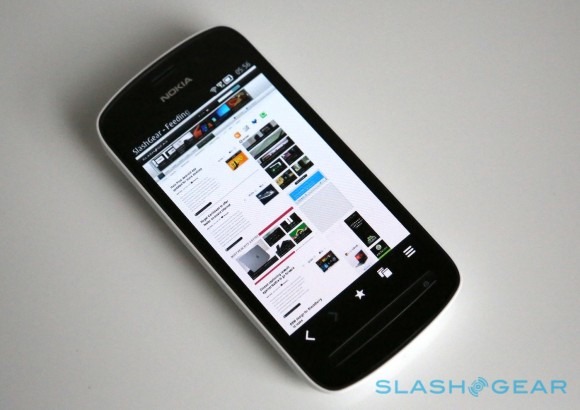
It's the browser that's the big nightmare, however, capable of paper of handling full sites but struggling with anything more complex than their mobile versions. Pinch zooming becomes trial and error, tedious since given the low resolution you'll probably be doing plenty of it. Swipe around the page and you have to wait a second or two for the screen to catch up with you. Flip from portrait to landscape orientation, or back again, and the lag shows itself once more. Most annoying though is how prone to crashing it is, the app periodically shutting down altogether. We didn't experience a full phone lock-up, but altogether it was enough to make us save our web browsing until we were home.
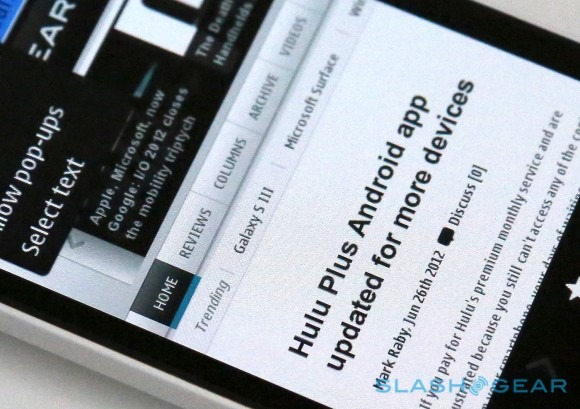
Oddly, we didn't experience the same sluggishness on the 808 PureView units running non-final software on our trip to Carl Zeiss several weeks ago. Then, the Nokia seemed as responsive as the 700 had been. It's possible that the final software tweaks have erred toward scaling back performance in favor of battery life, and if so we're hoping Nokia sees sense and tips the balance back a little toward usability with a firmware update.
Camera
Make no mistake, the Nokia 808 PureView is all about photography. Nokia's imaging team spent five years developing PureView – hence it being stuck with Symbian rather than getting Windows Phone like the Lumia series – and took the principles of mobile cameras back to basics in order to improve on quality.
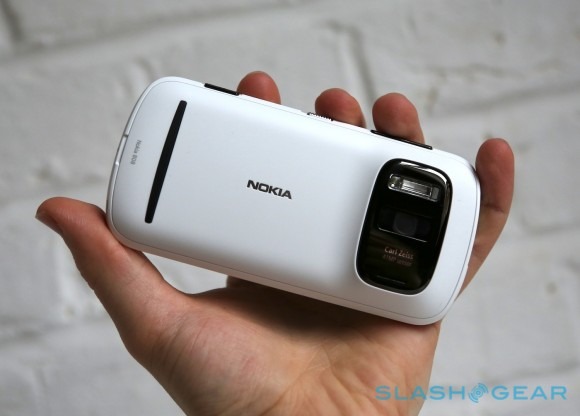
We've covered the technology behind PureView on the 808 comprehensively here, but the brief version is that it's a rethink of how lossless zooming can be supported on a phone. Traditionally that would demand an optical zoom lens, involving bulky moving parts; PureView does it instead with a surfeit of pixels. In PureView mode, the 808 uses its 41-megapixel sensor to capture more typical 2-, 5- or 8-megapixel shots, and in fact Nokia expects most owners to stick at 5-megapixel quality.
Nokia 808 PureView technology:
At 1x zoom, each pixel making up the final frame has around seven pixels on the sensor to feed into it, reducing the likelihood of a glitch or noise making it into the image. PureView can simply ignore any obvious outliers, making for more accurate shots. However, if you want to zoom in, the 808 can take a full-resolution (i.e. 2-, 5- or 8-megapixel) subset of the whole frame, similar to how a digital zoom magnifies a portion but with no loss in detail.
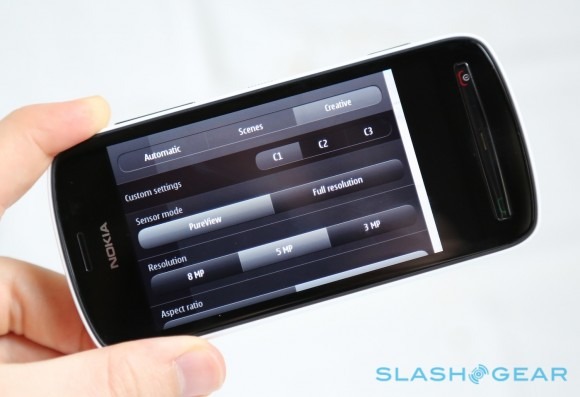
Exactly how much you can zoom depends on what PureView resolution you're using – the 808 won't allow you to get past the point where it can save a full-resolution image – so you get more range in 2-megapixel mode than you do at 8-megapixels. It averages at roughly 3x at 5-megapixels. The phone will also allow you to shoot at "full" resolution, either 34-megapixel 16:9 aspect images taken across the full width of the sensor, or 38-megapixel 4:3 aspect images taken across the full height of the sensor, though in that case you don't get any zoom option.
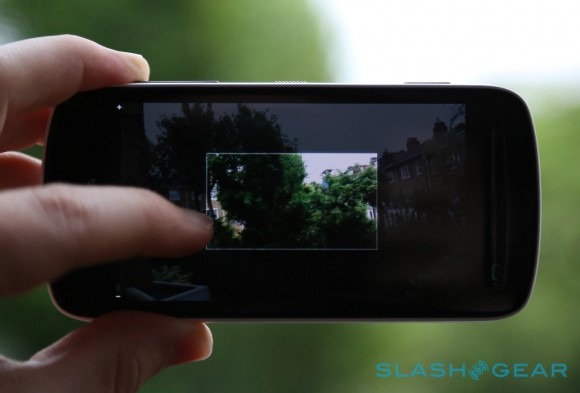
The 808's camera app has obviously changed from the Nokia Belle norm to accommodate PureView, and there are three key modes to choose between. Automatic strips you of all manual control bar toggling the Xenon flash between on/off/auto/red-eye modes, defaulting to roughly 5-megapixel frames, though you still get touch-focus. Scenes mode offers a choice of auto, landscape, portrait, sports, night, night portrait, spotlight and snow configurations, again with flash options and touch-focus.
Finally, there's Creative mode, where the guts of PureView are opened up to more avid tinkerers. The 808 can be toggled between PureView mode – with the choice of three resolutions and both 4:3 and 16:9 aspect ratios – and Full Resolution mode – with either 16:9 or 4:3 settings – and save in either Normal or Superfine JPEG quality modes. Color tones can be switched between normal, vivid, sepia or black & white, and there's optional bracketing, interval or self-timer modes. With interval, the 808 becomes a time-lapse camera, capable of shooting up to 1,500 images every 30 minutes (or as low as every 5 seconds).
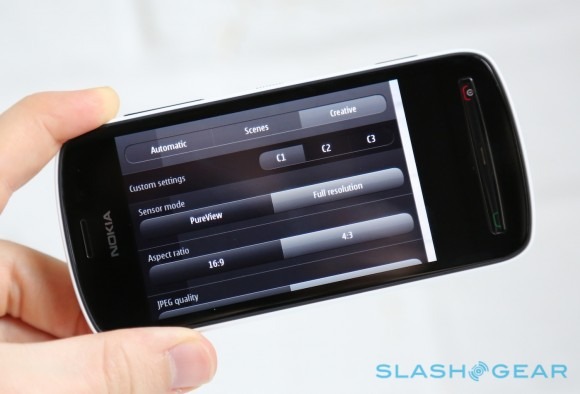
Then there are sliders for saturation, contrast and sharpness, while icons on the preview screen control flash, exposure, lighting type, ISO (from 50 – 1600, with an Auto mode) and the ability to turn off the neutral density filter. Once you have a clutch of settings you prefer, you can save them to one of the three custom shortcuts for easier retrieval.

Is it worth taking the time to play? Oh yes, yes it really is. We reluctantly left Carl Zeiss and our last experience with the 808 PureView wowed by quite how capable the new Nokia is, and nothing from our review unit has convinced us to think otherwise. This isn't just "good for a phone-camera" either; the 808 is easily able to produce shots that put dedicated point-and-shoots to shame.
Noise is almost non-existent, colors are as accurate as we've ever seen from a phone, and – as long as you take the time to tap the screen to set focus – crisp detail. Low light performance is hugely impressive, even before you bother turning on the (excellent) Xenon flash, as PureView squeezes all the extra pixel data into the final image.
In full resolution mode, meanwhile, you lack zooming ability but you get images of a scale that would traditionally demand a dedicated camera. There's something near-magical about being able to glance across an image, think "what's going on there?" and zoom in without facing a screenful of pixelated mush. At 34/38-megapixel resolution there's no PureView finessing going on – there aren't the extra pixels to enable it – but it does demonstrate just how capable the sensor and companion Zeiss optics are.
As for video, the 808 PureView will record in Automatic, Scenes (auto, low light, sports, spotlight and snow) or Creative modes, at 360p, 720p or 1080p resolution. A choice of 15, 24, 25 and 30fps frame rates are supported, plus the same color tone options as in stills mode, together with exposure and contrast. Since even 1920 x 1080 Full HD resolution doesn't come close to what the 808's sensor is capable of capturing, the same PureView oversampling is used to improve video quality, and just as with stills the evidence of that comes through in the final frame.
Nokia 808 PureView 1080p HD video sample:
Our only complaint is the somewhat sluggish continuous autofocus, which has a tendency to wander and is occasionally slow to refix. You can, however, tap to manually set a focus point. While your fingers are near the screen, it's worth playing with Nokia's clever zoom control: you can pinch-zoom, of course, but we found it easier to use the single-finger zooming where sliding your thumb up and down adjusts the degree of magnification. It's easy to keep both hands steadying the 808 and still zoom in, and when you're zooming during video capture the actual magnification doesn't happen until you lift your finger, allowing you to precisely frame without the hunting of regular systems. Alternatively you can use the zoom rocker, and unlike the stepped zoom levels of some devices, it's a silky-smooth transition.
Nokia 808 PureView 1080p HD video sample:
Audio during video recording is often overlooked, but Nokia has saved a little magic for that, too. The PureView has twin microphones for capturing stereo sound, but it also includes Rich Recording, a way to capture high-volume audio without suffering from distortion or clipping. In fact, Nokia claims the 808 is capable of handling four-times louder sound than regular phone microphones, without having to introduce the sort of filters that can leave the audio track weedy.
Going by Nokia's spec sheet, the 808 PureView should be able to capture the sound of a jet engine from 100-feet away without any stereo distortion. Topping out at 145dB, in fact, it's beyond the point where human ears would likely suffer permanent damage even if they're equipped with hearing protection. An average rock concert, meanwhile, at a more humble 115dB should be no problem at all for the 808 PureView, though we'll need to schedule one on our jam-packed social calendar to actually test that out.

Getting photos and video off the 808 is reasonably straightforward. The phone can be set to show up as a Mass Storage device when plugged in via USB, appearing on your PC or Mac as an external drive (rather than demanding a management app as per Windows Phone). However we were surprised to find transfers very sluggish to our test Mac: shuttling just over 440MB of photos and video took around five minutes, in fact. There's no native option to automatically upload images to an online gallery.
There are more 808 PureView camera samples here
The Future of PureView
Nokia has already confirmed that PureView technology won't be limited to just the 808. However, that's already prompted confusion around just what sort of resolution sensors we can expect in future Lumia Windows Phones. PureView does not necessarily mean 41-megapixels – Nokia picked that number to satisfy headlines and deliver a 3x optical zoom equivalent for 5-megapixel frames – but instead refers to the oversampling technology; a lower-resolution sensor would still deliver a lossless zoom, albeit with a smaller range, while allowing for a thinner device.
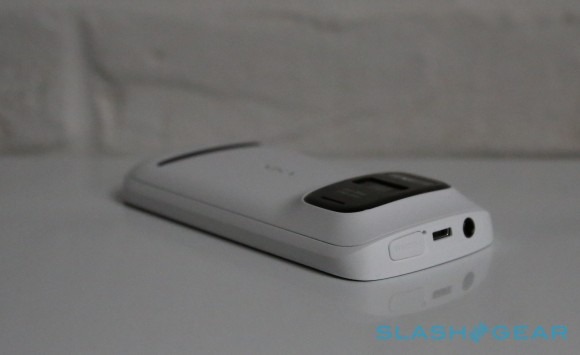
Phone and Battery
Nokia has a strong track record with phone radios, and the 808 PureView is no exception. We had no issues with keeping a signal, and the dual-microphones meant in-call audio was clear. The 808's 1,400 mAh battery is rated for up to 6.5hrs of 3G talk time or 540hrs of 3G standby, though the actual sort of longevity you'll see from it is very much dependent on how much you play with the camera. The Xenon flash in particular will chug through battery in short order. In practice, we managed a day of relatively eager use before we had to reach for the mains adapter.
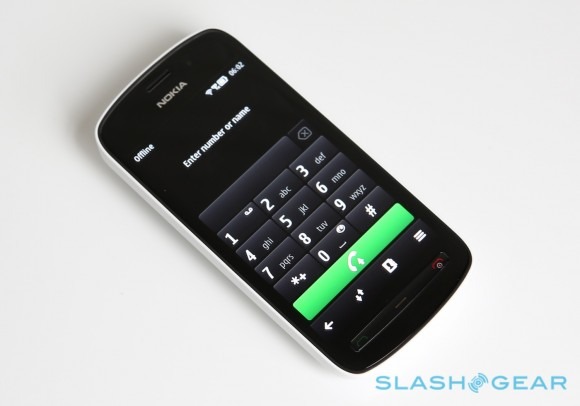
Wrap-Up
Viewed as a modern phone, the 808 PureView is a recipe for frustration. It's heavy and chunky, the screen lacks pixels, Nokia Belle is short on apps and long on aggravation, and even those apps that are onboard run with varying degrees of wretchedness on the wheezing processor. When the 808 starts to make more sense is when you flip it around, and consider it not so much a phone with an amazing camera, but an amazing camera with a 3G internet connection.
With such mundane matters as messaging, internet browsing, multimedia and apps left to a more flexible (but less photographically-capable) platform like iOS or Android, that frees up the 808 PureView to do what it undoubtedly does best: take awesome photos and video. If you can find space in your pocket or bag for two phones, and you're a keen shutterbug, then there are huge advantages to using the 808 rather than your regular phone camera.
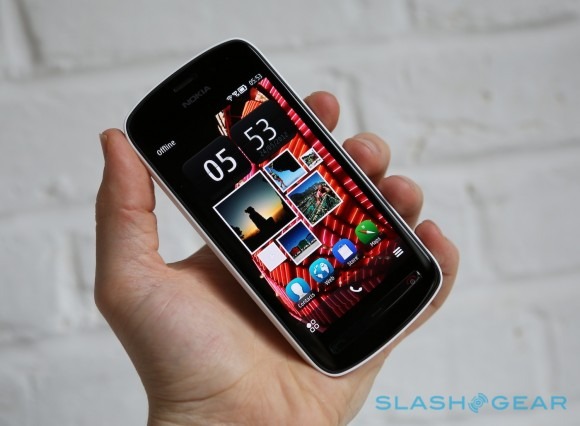
Therein lies the rub: at $699 unlocked and SIM-free in the US, it's an expensive second device. That would get you a good Micro Four Thirds camera, though blind testing suggests the 808 can produce photos as good as, or better than, such compacts. It would also be enough for an entry-level DSLR, though you'd lose any semblance of pocket-friendliness in that case.
In the end, though, even the fact that we're comparing the 808 PureView to DSLRs is testament to Nokia's achievement. Few people will actually go out and buy it themselves, but then the 808 is really a test bench for PureView technology, a proof-of-concept. Now that it has convinced us of its merits, Nokia can leverage the branding to differentiate its Windows Phone range. Frankly, the sooner it can do that, the better.
